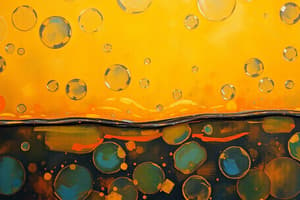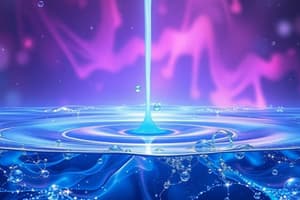Podcast
Questions and Answers
What is the primary factor that influences surface tension in a liquid?
What is the primary factor that influences surface tension in a liquid?
- Volume of the liquid
- Temperature of the environment
- Stronger intermolecular forces (correct)
- Molecular weight of the liquid
How does temperature affect surface tension?
How does temperature affect surface tension?
- It only increases at high temperatures
- It remains constant regardless of temperature
- It decreases as temperature increases (correct)
- It increases as temperature increases
What happens to energy during a phase transition from liquid to gas?
What happens to energy during a phase transition from liquid to gas?
- Energy is released to break intermolecular forces
- Energy is absorbed to form intermolecular forces
- Energy is absorbed to break intermolecular forces (correct)
- Energy remains unchanged during the transition
What describes the Boltzmann distribution?
What describes the Boltzmann distribution?
How does vapor pressure change with an increase in temperature?
How does vapor pressure change with an increase in temperature?
What does the Clausius-Clapeyron equation relate?
What does the Clausius-Clapeyron equation relate?
What is molar heat of vaporization (ΔHvap) indicative of?
What is molar heat of vaporization (ΔHvap) indicative of?
What is the relationship between ΔHvap and vapor pressure?
What is the relationship between ΔHvap and vapor pressure?
What determines the type of bond between two atoms?
What determines the type of bond between two atoms?
Which of the following molecules is polar?
Which of the following molecules is polar?
How is the dipole moment represented and calculated?
How is the dipole moment represented and calculated?
Why is carbon tetrachloride (CCl4) considered a nonpolar molecule?
Why is carbon tetrachloride (CCl4) considered a nonpolar molecule?
Electronegativity tends to increase in which direction on the periodic table?
Electronegativity tends to increase in which direction on the periodic table?
What does a ΔEN value greater than 1.8 indicate?
What does a ΔEN value greater than 1.8 indicate?
What are intramolecular forces?
What are intramolecular forces?
Which of the following is a type of intermolecular force?
Which of the following is a type of intermolecular force?
What causes diethyl ether to have a higher vapor pressure than water at a given temperature?
What causes diethyl ether to have a higher vapor pressure than water at a given temperature?
What defines the boiling point of a liquid?
What defines the boiling point of a liquid?
What does the molar heat of fusion represent?
What does the molar heat of fusion represent?
What role do intermolecular forces play in a substance?
What role do intermolecular forces play in a substance?
What does a phase diagram illustrate?
What does a phase diagram illustrate?
What indicates the relative densities of solid and liquid phases on a phase diagram?
What indicates the relative densities of solid and liquid phases on a phase diagram?
How is the heating curve related to phase transitions?
How is the heating curve related to phase transitions?
What does the triple point on a phase diagram represent?
What does the triple point on a phase diagram represent?
What happens to the vapor pressure of a solvent when solute is added?
What happens to the vapor pressure of a solvent when solute is added?
Which of the following colligative properties results from the addition of a solute to a solvent?
Which of the following colligative properties results from the addition of a solute to a solvent?
Boiling point elevation is directly related to which factor?
Boiling point elevation is directly related to which factor?
What is the role of the boiling point elevation constant (Kb)?
What is the role of the boiling point elevation constant (Kb)?
How does the addition of solute affect the phase diagram of a solution?
How does the addition of solute affect the phase diagram of a solution?
Which equation represents the change in freezing point depression?
Which equation represents the change in freezing point depression?
Which of the following ways to express solute concentration is temperature dependent?
Which of the following ways to express solute concentration is temperature dependent?
What is meant by colligative properties?
What is meant by colligative properties?
Which of these substances generally increases in solubility with rising temperature?
Which of these substances generally increases in solubility with rising temperature?
Which factor is NOT involved in the calculation of freezing point depression?
Which factor is NOT involved in the calculation of freezing point depression?
What does Henry's Law describe?
What does Henry's Law describe?
What are colligative properties primarily dependent on?
What are colligative properties primarily dependent on?
Which of the following is not a colligative property?
Which of the following is not a colligative property?
What is the van't Hoff factor (i) used to indicate?
What is the van't Hoff factor (i) used to indicate?
Why are electrolytes important in understanding colligative properties?
Why are electrolytes important in understanding colligative properties?
Which of the following represents a situation where solubility decreases as temperature increases?
Which of the following represents a situation where solubility decreases as temperature increases?
Flashcards are hidden until you start studying
Study Notes
Surface Tension
- Surface tension measures the energy required to increase a liquid's surface area, indicating its surface hardness.
- Higher intermolecular forces result in greater surface tension, making it tougher to penetrate the surface.
- Surface tension decreases with increasing temperature.
Phase Transitions and Energy
- Energy is absorbed during phase transitions to break intermolecular forces and released when these forces are formed.
Boltzmann Distribution
- The Boltzmann distribution graph represents molecular speeds at a specific temperature, with most molecules exhibiting intermediate speeds.
Vapor Pressure
- Vapor pressure is defined as the pressure exerted by vapor molecules above a liquid in a closed system, where evaporation equals condensation at equilibrium.
- Intermolecular forces and temperature affect vapor pressure; stronger forces yield lower vapor pressure, while higher temperatures increase it.
Clausius-Clapeyron Equation
- The equation relates temperature and vapor pressure: ln(P) = -ΔHvap/(R*T) + C, where ΔHvap is the molar heat of vaporization, R is the gas constant, T is temperature, and C is a constant.
- Diethyl ether has higher vapor pressure than water due to its weaker intermolecular forces.
Boiling Point
- The boiling point is the temperature at which vapor pressure equals external pressure, specifically observed at one atmosphere for the normal boiling point.
Molar Heat of Fusion and Sublimation
- Molar heat of fusion represents energy needed to melt a mole of solid and the energy released when a mole of liquid freezes.
- Molar heat of sublimation combines both the molar heat of fusion and molar heat of vaporization.
Heating Curve
- A heating curve illustrates how temperature changes in response to heat added to a system.
Intermolecular Forces and Properties
- Intermolecular forces determine key properties such as viscosity, surface tension, and vapor pressure.
Phase Diagrams
- Phase diagrams graphically depict phases of a substance at varying temperatures and pressures, showing phase transitions between solid, liquid, and gas.
- The triple point indicates conditions where all three phases coexist.
- The slope of the solid-liquid line indicates the densest phase under pressure, with positive slopes favoring solids.
Electronegativity and Bond Types
- Electronegativity quantifies an atom's ability to attract electrons, increasing across periods and decreasing down groups.
- A ΔEN less than 0.4 indicates nonpolar covalent bonds, while a ΔEN greater than 1.8 suggests ionic bonds.
Dipole Moments
- Dipole moments reflect the separation of charge over distance and are calculated using Q*r, where Q is the charge and r is the distance.
Molecular Polarity
- Carbon tetrachloride (CCl4) is nonpolar despite polar bonds due to symmetrical geometry.
- Chloroform (CHCl3) remains polar due to asymmetrical distribution of bond dipoles.
Intramolecular vs. Intermolecular Forces
- Intramolecular forces involve bonds within a molecule, influencing its structure.
- Intermolecular forces are weaker interactions impacting physical properties.
Concentrating Solutions
- Amounts of solute can be expressed as percent by mass, mole fraction, molarity, and molality, with molarity depending on temperature.
Solubility and Temperature
- The solubility of most solids increases with temperature; however, some salts, like Na2SO4, show decreased solubility with temperature.
Henry's Law
- Henry's law stipulates the concentration of gas in a solution correlates with its partial pressure above the solution.
Colligative Properties
- These properties depend on solute particle quantity, not identity, including vapor pressure lowering, boiling point elevation, freezing point depression, and osmotic pressure.
- Electrolytes enhance colligative properties via dissociation into ions in solution.
van't Hoff Factor
- The van't Hoff factor (i) represents the change in the number of particles due to solute dissociation.
Vapor Pressure Lowering
- Adding solute reduces the vapor pressure by decreasing the number of solvent molecules at the surface, impacting the mole fraction.
Boiling Point Elevation
- Boiling point elevation occurs due to vapor pressure lowering, requiring higher temperatures to match atmospheric pressure.
Freezing Point Depression
- Freezing point depression results from solute interference with solvent crystallization, calculated using ΔTf = i x m x Kf.
Studying That Suits You
Use AI to generate personalized quizzes and flashcards to suit your learning preferences.




